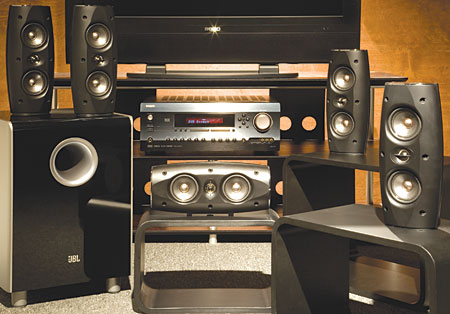JBL Cinema Sound CS6100 Speaker System and Integra DTR-7.7 A/V Receiver
At some point in the evolution of home theater, someone noticed that the phrase includes the word home. At that point, weird and wonderful things began to happen. Speakers morphed into smaller, more rounded, and occasionally more imaginative shapes. The surround receivers that fed them maintained their black-box identities but moved discreetly into closets. Back panels began to sprout extra jacks, the better to interact with touchscreen interfaces, second zones, and other niceties that have become staples of the connected home.

This month's Spotlight System splits the speaker/amp budget precisely in two, pairing a $1,199 speaker system with a $1,200 A/V receiver. The JBL CS6100 speaker system hails from the Cinema Sound series of sports satellites, but with an inverted-bottle shape—a home theater first. Integra's DTR-7.7 surround receiver augments its custom features with automatic setup and calibration, making it both installer friendly and DIY friendly—in other words, friendly.
Decanting the JBLs
Some speaker stands leap out of the box fully or partly assembled. Some take more work. The JBL speaker stands were among the latter, challenging me with four different varieties of screws. It took nearly a half hour to get the first stand right; once I had the hang of it, the rest took shape in five minutes each.
It was well worth the effort. The stand forms the neck of the CS6100's inverted-bottle shape, giving the speaker a unique, elegant, and pleasing look. Stare down at the top of the speaker, and you can see your face reflected in its shiny silver top panel, reminiscent of the back of an iPod. The enclosure is molded plastic, gloss black in the back, its shape broken only by the jutting binding posts. Drivers include a 0.5-inch version of JBL's famous titanium-laminate tweeter and a 3.5-inch mid-woofer made of what the company calls PolyPlas, a polymer-coated cellulose.
Some ingenuity went into the design of the stand, which has a cast-iron base bolted inside the outer aluminum base to give it more weight and stability. Even so, the base is somewhat shallow, so, if you've got toddlers (or a drinking problem), a wall mount would be safer. The satellites lend themselves to wall mounting—they're a little more than 3 inches deep and have a threaded insert hole at the bottom. JBL supplies mounting brackets with the product.
Always suspicious of horizontal centers, I bent the rules by arranging the three front satellites vertically on stands. I wanted the front soundstage to be as seamless as possible. The center appeared to be identical to the satellites except for the placement of its binding posts, so I used it and the remaining satellite on my existing stands in the back of the room. I also set aside the supplied 18-gauge zip cord and used my own 12-gauge Monster THX ribbon cable. The manual recommends 16-gauge or heavier wire for long cable runs. If you're décor conscious—a trait these speakers encourage—be sure that whatever cable you use is slender enough to fit through the stand's column and base.
Uncorking the Integra
Integra is Onkyo's smarter brother, as it were. The DTR-7.7 receiver is THX Select–certified and therefore guaranteed to perform well in a room of 2,000 cubic feet or less with THX Select2–certified speakers. With both XM Satellite Radio capability and a phono input, it confidently treads the corridors of time. And it expresses its superiority with other features that will appeal both to custom installers and to their savvier customers.
On the video side, the receiver upconverts all video sources to HDMI, so you can feed your display with one HDMI cable, period. While some receivers use HDMI only for video passthrough, this one's HDMI-repeater circuits can hand surround-sound signals to the internal decoder where appropriate, while they pass video to the display. The supported version of HDMI is 1.1. As usual, there are 7.1-channel analog inputs to provide future-proofing. In this case, bass management on the analog inputs is defeatable, so you can choose to enable it through either the receiver or your disc player. That's a good thing for early adopters of HD DVD and Blu-ray players, which have built-in decoders that operate through the analog outputs.
The DTR-7.7 also includes auto setup and calibration, which should sweeten the deal for DIY-inclined newbies. You don't have to be a custom installer to select speaker sizes and set levels—just plug the supplied microphone into the front panel, and the receiver does it for you. For more finicky users, there is a choice of a dozen crossover settings ranging from 40 to 200 hertz. With the JBLs, it was great to have seven choices north of the THX-specified 80-Hz crossover—those 3.5-inch woofers definitely needed upper-bass support from the sub. I also loved being able to use direct-access remote buttons to pick a channel and raise or lower the volume in that channel. That made it easy to perform on-the-fly corrections to, say, the sub level without having to delve into menus or interrupt the program.
- Log in or register to post comments




































































